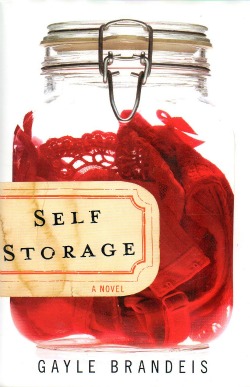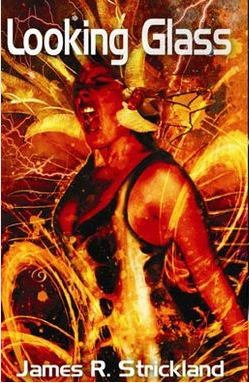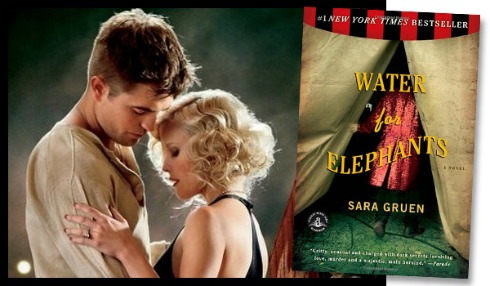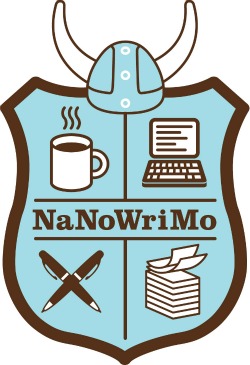National Novel Writing Month, more affectionately known as NaNoWriMo, started its thirteenth year last night/this morning at midnight. You have a month to write a 50,000-word novel—just creating, no editing or backtracking—and you’ve got 200,000 people working alongside you on their own passion projects. A wonderful component of NaNo is the public “write-ins” with your fellow novelists in your town, or online with other writers. There’s nothing like a shared goal to inspire you.
It also helps that there are a number of success stories where NaNo drafts eventually became published novels. And would you believe me if I told you that one of them was adapted into a 2011 movie starring Twilight‘s Robert Pattinson?

Gayle Brandeis, Self Storage
Brandeis’ novel bears some resemblance to Jonathan Safran Foer’s Extremely Loud and Incredibly Close: It’s a post-9/11 tale wherein a woman finds a mysterious note in a storage locker—reading simply “yes”—and searches out the owner of the unit. Brandeis wrote the book during the 2003 NaNo festivities and says that it really trained her to be more regimented and stick to concrete goals. “I found it interesting to work with a daily word count… it was so unlike my usual loosey-goosey process, and it led to some fun, surprising work,” she tells NPR. “It also taught me that I can be a disciplined writer if I need to be; now when I have a deadline, I give myself a daily word count to keep the words moving forward.”
Trish Doller, My Way or the Highway
Doller unabashedly admits that she wasn’t an “ideal” NaNo writer: She didn’t get very far when she tried in 2004 and 2005, and she didn’t complete her 2006 novel until July of 2007. But those extra months of writing helped her complete a draft, which was enough to get the attention of the agent who represented the book that first inspired Doller to write. After she got representation, everything came in a flurry: Sale, revisions, publication!
Lani Diane Rich, Time Off for Good Behavior and Maybe Baby
Rich is an example of the reluctant novelist who figures she’ll throw caution to the wind with this thirty-day experiment and winds up with a writing career out of it. Her first NaNo was in 2003; according to NaNoWriMo founder Chris Baty, Rich’s manuscript for that year nabbed her a two-book deal with Warner Books. She holds the very specific honor of being the first unpublished author who published a NaNovel.

James R. Strickland, Looking Glass
The official list of published NaNovelists (about 30 in total) is mostly female, but there are a couple men who clawed their way up as well. Strickland offers some fascinating insight into the long, grueling process of shaping his first cyberpunk novel. He reminds his readers that the 50,000-word NaNovel should be a beginning point, not a completed draft; in revising Looking Glass, he “tore out close to half the body of the Nano draft and rewrote or replaced the scenes.” But he didn’t even get into the groove of writing the book (in 2004) until he transplanted the world of a failed cyberpunk novel he started in 1990. Another huge impact on writing his first draft was the 2004 election that took place that November.
Julia Crouch, Cuckoo
Crouch credits the extensive NaNo community with providing quick answers and insights; otherwise, the labor of fact-checking would seriously slow down her or any other writer. Writing the thriller Cuckoo also taught her to just trust her instincts. “If a new story thread comes up that I have not prepared for,” she says, “or a character develops a new trait that was unforeseen, I just roll with it.”
Sara Gruen, Water for Elephants

Arguably the most mainstream success story, Gruen is a NaNo superstar who’s used the annual write-a-thon to draft three novels. Her most well-known, Water for Elephants, became a New York Times bestseller and was adapted into the movie starring Robert Pattinson and Reese Witherspoon. (However, though she got a writing credit on IMDb for the novel, Gruen didn’t write the screenplay. That honor went to screenwriter Richard LaGravenese, who did P.S. I Love You and The Horse Whisperer.)
Gruen was asked to write a Pep Talk for NaNo-ers in 2007, where she confessed to falling behind on word count but still imparted valuable advice: “However far behind you are, take comfort in knowing that there is somebody else out there in the same boat, and look for that next fun scene. And then the next. And if that doesn’t work, set someone on fire. In your book, of course.”
However, Chris Baty stresses that “success” in NaNo doesn’t necessarily equal publication. “I read through the NaNoWriMo forums at the end of the event every year,” he says, “and always get weepy at the posts where people say: ‘I just did this thing I never thought I could do. I found a part of myself that I didn’t know existed. And now I’m wondering what else is in there.'”
While you’re tapping away the keys, here are some pep talks from people who have also been there and back: Neil Gaiman, Tamora Pierce, Lemony Snicket, Philip Pullman, Naomi Novik, Maureen Johnson, Holly Black, Piers Anthony, and the late Brian Jacques.
So, what about you? Are you participating in NaNoWriMo? Did you participate last year? What are your goals this time around? Share and share alike! Let’s talk about tomorrow’s classics! (And oxymorons, while we’re at it…)
A huge thank-you to Oakton Community College, whose research into published NaNo novels gave me several starting points for this post.
Natalie Zutter is a playwright, foodie, and the co-creator of Leftovers, a webcomic about food trucks in the zombie apocalypse. She’s currently the Associate Editor at Crushable, where she discusses movies, celebrity culture, and internet memes. You can find her on Twitter.










